
US Navy presses Arab media charm-offensive, but what next?
I'm not ungrateful. Spending two days aboard an aircraft carrier isn't something many non-military people ever get to do. Even of the 5,300 crew of the USS Dwight D Eisenhower, fewer than ten percent will ever make it onto the flight deck during operations. It was a once-in-a-lifetime opportunity for a boy who watched Top Gun on loop for much of the 1980s.
The US military knows all about being on the offensive. From its projection of raw military might to its charming of journalists - hard power and soft power, hand in hand.
We were given unprecedented access on our visit, from being flown in on a cargo plane and making a tail-hook landing (decelerating from 180mph to 0 in two seconds is quite the life experience) to being helicoptered off again on an anti-submarine warfare Seahawk flying 140 knots at 500 feet.
True, we were accompanied by a Navy public affairs officer at every waking moment, from the operations bridge to the bathroom - but I do believe this was motivated just as much by their desire for us not to get lost (as we inevitably
would aboard this 20-storey floating city) as by them wanting to protect any top-secret areas or equipment.
Despite our supervision, we were encouraged to take photos, to speak to any crew members - not just those with whom we had requested interviews ahead of the trip.
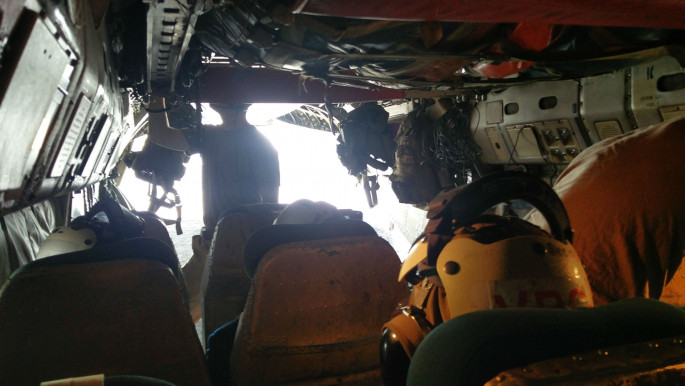 |
|
| No drinks trolley on this flight |
The US Navy had invited a very limited selection of Arab media - along with your humble correspondent, there were representatives of Asharq al-Awsat (the London-based, green-tinted, Saudi-royal-owned broadsheet), Al-Quds al-Arabi (the populist daily), as well as TV crews from al-Arabiya (the Saudi pan-Arab channel) and Bahrain TV - to cover the Eisenhower's efforts in Operation Inherent Resolve.
It was as if to score some good press in the Arab region for the US military's efforts to fight the Islamic State group, they wanted to throw everything at impressing us. And, if we're going to be completely honest here, it was pretty impressive.
It's difficult not to be impressed. The Navy really went overboard. The admiral's personal chef had wanted to make us a special Arabic meal, so had particular spices specially flown in from Bahrain. That said, it's not every day you to get to have dinner sat between a US admiral and the commander of a carrier strike group's air fleet, while opposite the captain of the ship - himself a fighter jet pilot and former Top Gun graduate and instructor.
Not your run-of-the-mill Islington dinner party.
But it wasn't the dinner, nor was it the personalised water bottles, nor being called "sir" all the time that was impressive.
What was genuinely impressive was the sheer professionalism and organisation displayed in every direction and at every hour. Those of us who work in the media are used to dealing with the most mind-numbing incompetence every day of our working lives - from governments to sources to conspiracists emailing us abuse because we haven't printed the latest psychedelic theory about walnuts.
 |
|
| Read more: Exclusive report from the aircraft carrier bombing Syria and Iraq [James Brownsell] |
But here is a gargantuan vessel - truly the ultimate behemoth of military engineering - with a crew of thousands of highly trained and disciplined professionals.
During flight deck operations, the sheer noise and power of jet engines firing up just feet away, despite foam ear plugs and ear defenders built into helmets, is simply bone-shaking. And as these multi-million dollar aircraft and their highly explosive payloads and fuel are catapulted off the ship, and caught again by steel cables upon landing, the danger is only too obvious.
Yet dozens of men and women work with professionalism and precision; each knows where they are meant to be, what they are meant to be doing and when they are meant to be doing it.
 |
There is always a moral dilemma for journalists on a military embed |  |
There is always a moral dilemma for journalists on a military embed. What the military wants to get out of it isn't necessarily what the journalist wants to get out of it. For a pacifist, it places you in a further dichotomy when confronted with these instruments of war, these machines of death - yet feeling the surge of adrenaline as they rocket past.
Before I was a journalist - before I was a pacifist - I was a child during the Cold War. Like pretty much every other kid on my block, I wanted to be a fighter pilot. Being on the Eisenhower's flight deck was the stuff of childhood dreams. But I am no longer a child. And when I became a man, when first confronted by my own mortality in a warzone, I attempted to put away those childish things.
 |
|
| In pictures: Click here for more photos from the USS Eisenhower [James Brownsell] |
I have been on the ground in the occupied West Bank when very similar planes, owned by the Israeli military, circle overhead.
I have shared my friends' fear of not knowing if or when they may strike. I have seen the aftermath of their destructive and deadly power. I have been to the funerals.
These machines, and their power, are intoxicating to be around. But journalists must try to stay grounded - even when flying at high speeds in an attack helicopter. Between these aircraft taking off and them landing again, people died. Maybe they deserved to, but I'm not someone who could make that call.
F-18 pilot Lieutenant Julius "Whiskers" Bratton told me that targeteers assess the potential for civilian deaths long before the mission takes off, and that he makes a second assessment from the cockpit once he reaches his target, and would abort a strike if, for example, the targeted vehicle believed to be full of IS militants entered a civilian neighbourhood.
Monitoring groups who report that aircraft from the US-led coalition bombing Iraq and Syria are responsible for the deaths of hundreds of civilians - as many as 900 by one account - do admit that the US makes every effort to avoid
civilian deaths. They don't apply that caveat to the Russian air force, who are blamed for more than 3,600 civilian deaths in Syria.
Bratton also told me that he packs snacks for long flights and enjoys munching on a grilled cheese sandwich while flying a $40 million jet at speeds way beyond 300mph ("the guys in the kitchen often write little notes on the
packet like 'have a safe flight' or whatever, and it's just like yo' momma packing you off to school with lunch").
I like high speeds. I like cheese sandwiches. But it's time to face facts. I could never be a fighter jet pilot. I couldn't press the button. I couldn't get over the fact that, as songwriter David Rovics puts it, "for every laser-
guided pin-prick there are lives lost in the smoke".
This is what warfare is all about, after all - the taking of the enemy's life.
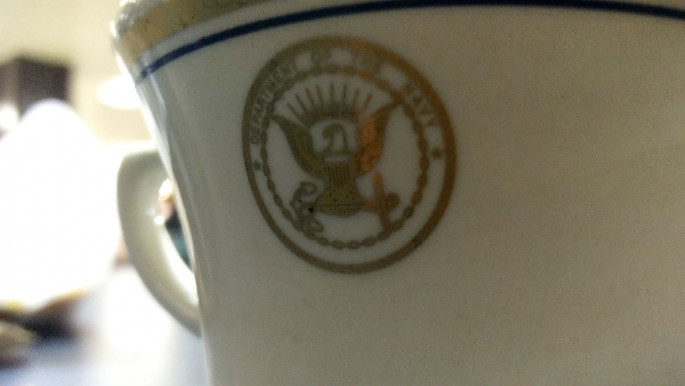 |
|
| I promise I did not steal this teacup |
The goal of defeating the barbarous Islamic State group is no doubt laudable.
IS has been public enemy number one since their snuff films of brutal executions made their way online. When al-Qaeda said they were "too extreme", it
only helped their brand.
And the US military, led ably by the sailors and aviators of the USS Dwight D Eisenhower, is fighting that fight in the skies above Mosul and Deir az-Zour. The Iraqis and Syrians resisting the butchers on the ground need their support, it is true.
But the question that remains unanswered is this: what is next?
What happens after IS is defeated on the battlefield? Even if, somehow, an end to the group's ability to hold territory also meant an end to their perverse ideology (which it won't, but that's another matter), what happens to the people of Iraq and Syria?
In Iraq, sectarian militia have been fighting to rid the land of IS not simply to liberate the people trapped under their rule, but to carve out territory for themselves.
In Syria, where IS is thought to have killed more than 3,000 people, President Bashar al-Assad and his allies have slaughtered more than 150,000 of their own countrymen and women. With rhetoric from Damascus that condemns all opposition - from the formerly al-Qaeda-affiliated ex-Nusra Front, through the Western-supported Free Syrian Army to non-violent media activists and rescue workers - as "terrorists", this mass murder isn't going to stop with the defeat of IS.
What then for the US and international military intervention?
The US Navy, the backbone of the international community's "liberal" humanitarian interventions, has had a base on the distinctly illiberal island of Bahrain - where foreign critical journalists are barred from entry while domestic dissidents are jailed and believed to be tortured - for at least 45 years. The UK, too, is renewing its military presence on the island as it bolsters its ties to the Gulf in the wake of the Brexit vote.
It is difficult to imagine a future Middle East without some form of US or British military presence. That future doesn't appear likely anyway. But what form will that presence take? And who will be their next target?
The US aircraft carrier is almost certainly the world's premier instrument of war. Its crew are probably the world's best-defended troops. The crew of the USS Dwight D Eisenhower, though their work is hard and daunting, will be just fine.
For the people of Iraq and Syria, the future is a lot less certain.
Follow James Brownsell on Twitter: @JamesBrownsell
![[DOD]James aboard USS Dwight D Eisenhower [DOD]James aboard USS Dwight D Eisenhower](/sites/default/files/styles/large_16_9/public/media/images/22C99825-A0CC-48C8-92AC-DAC0049E9A91.jpg?h=d1cb525d&itok=WPfBaIKG)
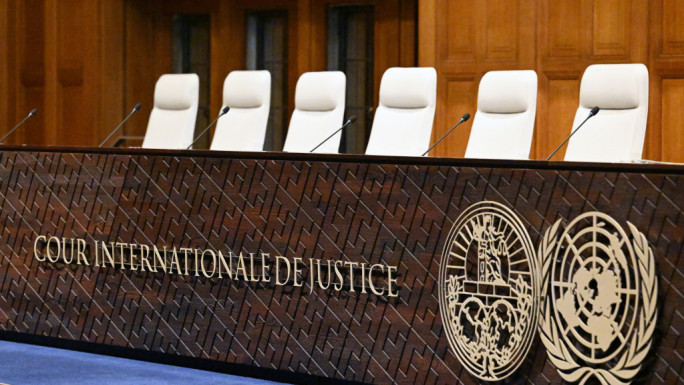
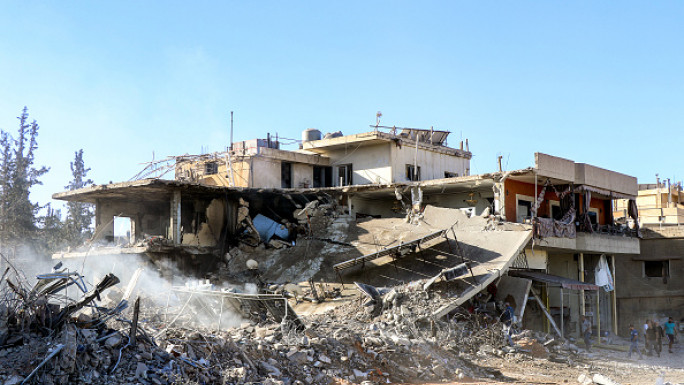
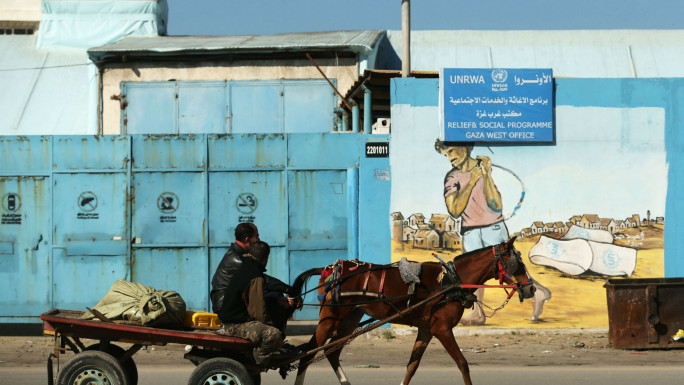

 Follow the Middle East's top stories in English at The New Arab on Google News
Follow the Middle East's top stories in English at The New Arab on Google News


